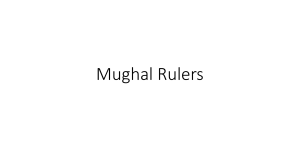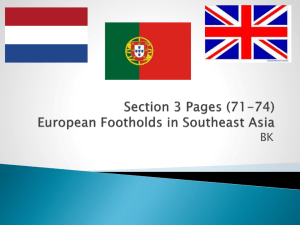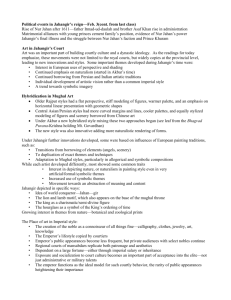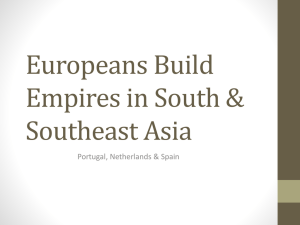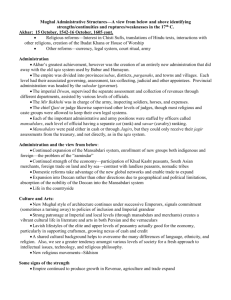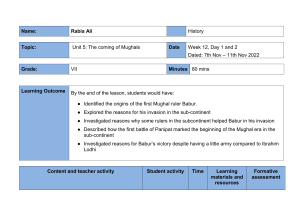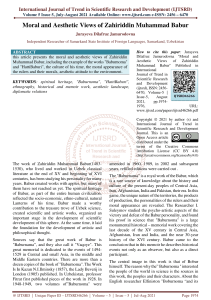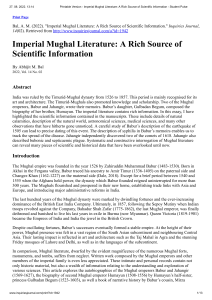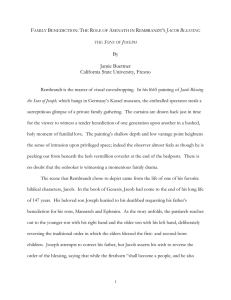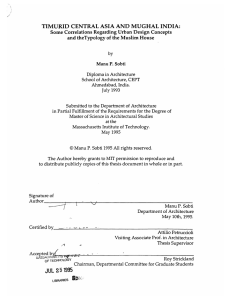Mughal Empire, European Explorers and Baroque Art
advertisement
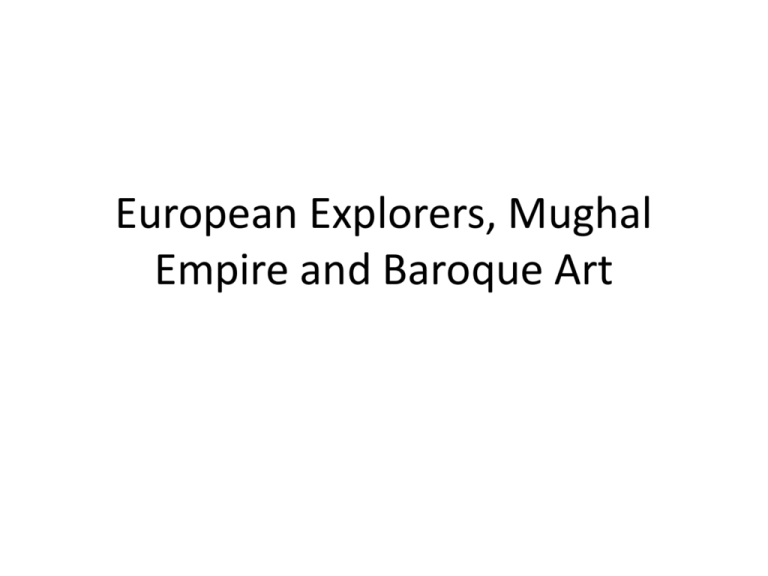
European Explorers, Mughal Empire and Baroque Art Portuguese Explorers • Vasco Da Gama • 1394 – 1460 Prince Henry the Navigator • Patron of exploration, maritime trade, Age of Discoveries, interested in legend of Prestor John • 1519 – 1522 Magellan’s (sailing under Spanish crown) first circumnavigation around the world, died in Battle of Mactan (Philippines) • 1580 – Philip II of Spain annexes Portugal, loyalists held out in Azores (still part of Portugal today) until 1583 Magellan’s Circumnavigation, 15191522 Portugal Overseas Spanish Explorers • • • • • • • • • • • • 1492 (1st voyage) – Columbus (Geonan) visits Bahamas, Cuba and Hispaniola 2nd voyage – Jamaica, Puerto Rico 3rd voyage – South America 1513 – Ponce de Leon lands in Florida 1513 – Balboa sees Pacific (Panama), accompanied by Pizzarro 1520 – conquistador Cortez conquers Aztecs and King Montezuma II Cortez mistaken for Quetzalcoatl Tenochtitlan – capital of Aztecs 1526 – Pizzarro conquers Incas (Cuzco), accompanied by De Soto Atahualpa had overthown half-brother Huascar 1540 – Coronado explores SW 1541 - DeSoto crosses Mississippi Spanish-Portuguese Territories British Explorers • Iberian Union 1580-1640 • British maritime trade expanded after defeat of Spanish Armada in 1588 • 1540 – 1596 Sir Francis Drake – 1st English discovery of New World, claimed part of California for Elizabeth, 1st Englishman to circumnavigate the world, Golden Hind • 1554 – 1618 Sir Walter Raleigh – named Virginia after Elizabeth, Roanoke Colony, tried to find El Dorado Babur and the Mughal Empire • • • • • • • • • • Born 1483 in Central Asia Descendant of both Genghis Khan and Tamerlane 1495 – Ruler of Farghana Sieged Samarkand (Tamerlane’s old capital) several times 1504 – crossed Hindu Kush and captured Kabul 1513 – Ottoman Empire agreed to help Babur in his conquests 1526- First Battle of Panipat, last king of Lodi Dynasty killed Babur took Delhi and Agra Declared formation of Mughal Empire 1531 – Succeeded by son Humayun Akbar the Great • Grandson of Babur • Emperor 1556-1605 • Repealed Muslim jizya tax, created Din-i-Ilahi • “Gunpowder Empire” • Capital Fatehpur (City of Victory), moved capital to Agra • Jesuits from Goa Akbar International Relations • Ottoman Suleiman the Magnificent tried to get Mughal help to weaken Portuguese navy • Received envoys from Queen Elizabeth I • Married Hindu Rajpat princess • Grandson Shah Jahan, builder of Taj Mahal in Agra • Jahangir rebelled against him The British East India Company • 1600 – Royal Charter given by Elizabeth I • Oldest European east Indies company • Had their own military • Charter gave monopoly on all trade between Cape of Good Hope and Straits of Magellan • Dutch East India Company major competitor • Jahangir gave BEIC permission • "Upon which assurance of your royal love I have given my general command to all the kingdoms and ports of my dominions to receive all the merchants of the English nation as the subjects of my friend; that in what place soever they choose to live, they may have free liberty without any restraint; and at what port soever they shall arrive, that neither Portugal nor any other shall dare to molest their quiet; and in what city soever they shall have residence, I have commanded all my governors and captains to give them freedom answerable to their own desires; to sell, buy, and to transport into their country at their pleasure. For confirmation of our love and friendship, I desire your Majesty to command your merchants to bring in their ships of all sorts of rarities and rich goods fit for my palace; and that you be pleased to send me your royal letters by every opportunity, that I may rejoice in your health and prosperous affairs; that our friendship may be interchanged and eternal" • —Nuruddin Salim Jahangir, Letter to James I. Baroque Style: Music, Architecture, Sculpture, Painting • Handel – Water Music • Bach – Well-Tempered Clavier, Mass in B Minor, Brandenburg Concertos • Vivaldi – Four Seasons • Pachelbel – Canon in D Major – Architecture: grandeur & impressive, flashy designs – Painting: intense lighting/shading – Lots of Baroque art was a reaction to Reformation Comparing Renaissance and Baroque The Calling of St. Matthew, 1600 by Caravaggio • • • Italian Light leads to Matthew Extreme chiaroscuro, called tenebrism Judith Beheading Holofernes, 1599 by Caravaggio • • • Emotion Judith in light and white Lines lead to head The Ecstasy of St. Theresa, by Bernini • • • • • Italian artist, sculptor Face, toes Arrow piercing heart drapery Notable works: Fountain of Four Rivers; four sculptures of gods to represent the Nile, La Plata, Danube, and Ganges Apollo and Daphne St. Peter’s Basilica; made the baldacchino (canopy) beneath the dome More Bernini Apollo and Daphne Baldachino above altar of St. Peter’s Las Meninas, 1656 by Diego Velasquez • • • • • • Spanish court painter Man in door Dwarf Dog Subjects in mirror Painter painted himself Girl with a Pearl Earring, 1665 by Johannes Vermeer • • • Dutch Light from the left Earring attracts light The Nightwatch, by Rembrandt • • • • • • • • Dutch part of the “Dutch Golden Age” Wife, Saskia, included in some of his works Military group Woman holding chicken Shield with 18 names Dog barking at drummer Notable works: Belshazzar’s Feast: Babylonian king watches illuminated Hebrew letters being writ on a wall Anatomy Lesson of Dr. Nicolaes Tulp, 1632 by Rembrandt • • Typical Dutch attire Examining forearm Aristotle Contemplating the Bust of Homer, by Rembrandt The Three Graces, by Peter Paul Rubens • • Rubenesque bodies Lighter flesh tones

